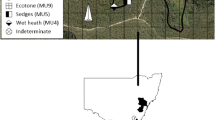Abstract
Studies to identify gaps in the protection of habitat for speciesof concern have been inconclusive and hampered by single-scale orpoor multi-scale sampling methods, large minimum mapping units(MMU's of 2 ha to 100 ha), limited and subjectively selected fieldobservations, and poor mathematical and ecological models. Weovercome these obstacles with improved multi-scale samplingtechniques, smaller MMU's (< 0.02 ha), an unbiased sampling designbased on double sampling, improved mathematical models includingspecies-area curves corrected for habitat heterogeneity, andgeographic information system-based ecological models. We applythis landscape analysis approach to address resource issues inRocky Mountain National Park, Colorado. Specifically, we quantifythe effects of elk grazing on plant diversity, identify areas ofhigh or unique plant diversity needing increased protection, andevaluate the patterns of non-native plant species on thelandscape.
Double sampling techniques use satellite imagery,aerial photography, and field data to stratify homogeneous andheterogeneous units and “keystone ecosystems” (ecosystems thatcontain or support a high number of species or have distinctivespecies compositions). We show how a multi-scale vegetationsampling design, species-area curves, analyses of within- andbetween-vegetation type species overlap, and geographic informationsystem (GIS) models can be used to quantify landscape-scalepatterns of vascular plant diversity in the Park.
The new multi-scale vegetation plot techniques quickly differentiated plantspecies differences in paired study sites. Three plots in the OuzelBurn area (burned in 1978) contained 75 plant species, while only17 plant species were found in paired plots outside the burn.Riparian areas contained 109 plant species, compared to just 55species in paired plots in adjacent forests. However, plant speciesrichness patterns inside and outside elk exclosures were morecomplex. One elk exclosure contained more species than its adjacentopen range (52 species inside and 48 species outside). Two elkexclosures contained fewer species inside than outside (105 and 41species inside and 112 and 74 species outside, respectively).However, there was only 26% to 48% overlap (using Jaccard'sCoefficient) of plant species composition inside and outside theexclosures. One elk exclosure had 13% cover of non-indigenousspecies inside the exclosure compared to 4% outside, butnon-indigenous species cover varied by location.
We compared plantdiversity patterns from vegetation maps made with 100 ha, 50 ha, 2ha, and 0.02 ha MMU's in the 754 ha Beaver Meadows study area usingfour 0.025 ha and twenty-one 0.1 ha multi-scale vegetation plots.Preliminary data suggested that the 2 ha MMU provided an accurateestimate of the number of plant species (–14%) for a study area,but the number of habitats (polygons) was reduced by 67%, andaspen, a unique and important habitat type, was missed entirely. Wedescribe a hypothesis-driven approach to the design andimplementation of geospatial databases for local resourcemonitoring and ecosystem management.
Similar content being viewed by others
References
Agee, J.K. and D.R. Johnson, 1988. Ecosystem management for parks and wilderness. Univ. of Washington Press, Seattle.
Berry, J.K. 1993. Beyond Mapping: Concepts, Algorithms, and Issues in GIS. GIS World, Inc. Fort Collins.
Boeresma, M., C.P. van Schaik and P. Hogeweg, 1991. Nutrient gradients and spatial structure in tropical forests: a model study. Ecol. Mod. 55: 219–240.
Brown, J.H. 1984. On the relationship between abundance and distribution of species. American Naturalist 124: 255–279.
Buckley, D.J., M.B. Coughenour, C.B. Blyth, D.J. O'Leary and J.A. Bentz, 1993. Ecosystem Management Model–Elk Island National Park: A Case Study of Integrating Environ-mental Models with GIS. Second International Conference on Integrating GIS and Environmental Modeling. Breckenridge, Colorado.
Burgman, M.A., S. Ferson and H.R. Akcakaya, 1993. Risk assessment in conservation biology. Chapman and Hall, London.
Chadde, S.W. and C.E. Kay, 1991. Tall-willow communities on Yellowstone's northern range: a test of the “natural regulation” paradigm. InThe Greater Yellowstone Ecosystem. pp. 231–262. Edited by R.B. Keiter and M.S. Boyce. Yale Univ. Press, New Haven.
Chapin, F.S., P.M. Vitousek and K. Van Cleve, 1986. The nature of nutrient limitation in plant communities. American Naturalist 127: 48–58.
Congalton, R.G. 1991. A review of assessing the accuracy of classification of remotely sensed data. Remote Sens. Environ. 37: 35–46.
Coughenour, M.B. 1991. A GIS/RS based modeling approach for a pastoral ecosystem in Kenya. InProceedings Resource Technology 90–Second International Symposium on Advanced Technology in Natural Resource Management, American Society Photogrammetry and Remote Sening. Falls Church, Bethesda, MD.
Coughenour, M.B. 1992. Spatial modeling and landscape characterization of an African pastoral ecosystem: a prototype model and its potential use for monitoring drought. InEcological Indicators Vol. 1. pp. 787–810. Edited by D.H. McKenzie, D.E. Hyatt and V.J. McDonald. Elsevier Applied Science, New York.
Coughenour, M.B. 1993. Savanna–Landscape and Regional Ecosystem Model: documentation, Natural Resources Ecology Laboratory, Colorado State University, Fort Collins, Colorado 80523.
Coughenour, M.B. and F.J. Singer, 1991. The concept of over-grazing and its application to Yellowstone's northern Range. InThe Greater Yellowstone Ecosystem. pp. 209–230. Edited by R.B. Keiter and M.S. Boyce. Yale Univ. Press, New Haven.
DeByle, N.V. 1985a. Wildlife. InAspen: Ecology and Management in the Western United States. pp. 135–152. USDA Forest Service General Technical Report RM-119, Ft. Collins, CO.
DeByle, N.V. 1985b. Animal impacts. InAspen: Ecology and Management in the Western United States. pp. 115–123. USDA Forest Service General Technical Report RM-119, Ft. Collins, CO.
Franklin, J.F. 1993. Preserving biodiversity: species, ecosystems, or landscapes? Ecol. Appl. 3: 202–206.
Holland, E.A., W.J. Parton, J.K. Detling and D.L. Coppock, 1992. Physiological responses of plant populations to herbivory and their consequences for ecosystem nutrient flow. Am. Nat. 140: 685–706.
Jones, J.R. and N.V. DeByle, 1985. Fire. InAspen: Ecology and Management in the Western United States. pp. 77–81. USDA Forest Service General Technical Report RM-119, Ft. Collins, CO.
Kalkhan, M.A. 1994. Statistical properties of six accuracy in-dices using simple and stratified random sampling: An application in remote sensing. Ph.D. dissertation, Colorado State University, Fort Collins, CO.
Kalkhan, M.A., T.J. Stohlgren and M.B. Coughenour, 1995. An investigation of biodiversity and landscape-scale gap patterns using double sampling: a GIS approach. Paper presented at the 9th Annual Symposium on Geographic Information Systems. March 27–30, 1995. Vancouver, British Columbia, Canada. In press.
Krebs, C.J. 1989. Ecological Methodology. Harper & Row, New York.
LaRoe, E.T. 1993. Implementation of an ecosystem approach to endangered species conservation. Endangered Species Up-date 10: 3–6.
Levin, S.A. 1976. Population dynamics in spatially complex environments. Ann. Rev. Ecol. and Syst. 7: 287–310.
Liu, J. 1993. Discounting initial population sizes for prediction of extinction probabilities in patchy environments. Ecol. Mod. 70: 51–61.
Maybeck, P.S. 1979. Stochastic Models, Estimation, and Control, vol. 1. Academic Press, New York.
McInnes, R.J., J. Naimann, J. Pastor and Y. Cohen, 1992. Effects of moose browsing on vegetation and litter of the boreal forest, Isle Royale, Michigan, USA. Ecology 73: 2059–2075.
Mueggler, W.F. 1985. Forage. InAspen: Ecology and Management in the Western United States. pp. 129–134. USDA Forest Service General Technical Report RM-119, Ft. Collins, CO.
Noss, R. 1983. A regional landscape approach to maintain diversity. BioScience 33: 700–706.
Pastor, J.M., R.J. Naiman and B. Dewey, 1987. A hypothesis of the effects of moose and beaver foraging on soil nitrogen and carbon dynamics, Isle Royale. Alces 23: 107–124.
Peet, R.K. 1988. Forests of the Rocky Mountains. InNorth American Terrestrial Vegetation. pp. 64–103. Edited by M.G. Barbour and W.D. Billings. Cambridge Univ. Press, Cambridge.
Pielou, E.C. 1961. Segregation and symmetry in two species populations as studied by nearest neighbor relations. J. Ecol. 49: 255–269.
Pielou, E.C. 1977. Mathematical Ecology. John Wiley and Sons, New York.
Pulliam, H.R. 1988. Sources, sinks and population regulation. Am. Nat. 132: 652–661.
Pulliam, H.R., J.B. Dunning Jr. and J. Liu, 1992. Population dynamics in complex landscapes: a case study. Ecol. Appl. 2: 165–177.
Romme, W.H., M.G. Turner, L.L. Wallace and J.S. Walker, 1995. Aspen, elk, and fire in northern Yellowstone national Park. Ecology 76: 2097–2106.
Salt, G.W. 1957. An analysis of avifaunas in the Teton Mountains and Jackson Hole, Wyoming. The Condor 59: 373–393.
Scott, M.J., F. Davis, B. Csuti, R. Noss, B. Butterfield, C. Groves, H. Anderson, S. Caicco, F. D'Erchia, T.C. Edwards, J. Ulliman and R.G. Wright, 1993. GAP Analysis: A Geo-graphic Approach to Protection of Biological Diversity. Wildlife Monographs 123: 1–41.
Shmida, A. 1984. Whittaker's plant diversity sampling method. Israel Journal of Botany 33: 41–46.
Shugart, H.H. 1984. A theory of forest dynamics. Springer-Verlag, Berlin.
Stohlgren, T.J. 1994. Planning long-term vegetation studies at landscape scales. InEcological Time Series. pp. 209–241. Edited by T. Powell and J. Steele. Chapman and Hall, New York.
Stohlgren, T.J., M.B. Falkner and D. Schell, 1995a. A modified-Whittaker nested vegetation sampling method. Vegetation 117: 113–121.
Stohlgren, T.J., J.F. Quinn, M. Ruggiero and G. Waggoner, 1995b. Status of biotic inventories in U.S. National Parks. Biol. Cons. 71: 97–106.
Strittholt, J.R. and R.E.J. Boerner, 1995. Applying biodiversity Gap Analysis in a regional nature reserve design for the edge of Appalachia, Ohio (U.S.A.). Cons. Biol. 9: 1492–1505.
Author information
Authors and Affiliations
Rights and permissions
About this article
Cite this article
Stohlgren, T.J., Coughenour, M.B., Chong, G.W. et al. Landscape analysis of plant diversity. Landscape Ecology 12, 155–170 (1997). https://doi.org/10.1023/A:1007986502230
Issue Date:
DOI: https://doi.org/10.1023/A:1007986502230




